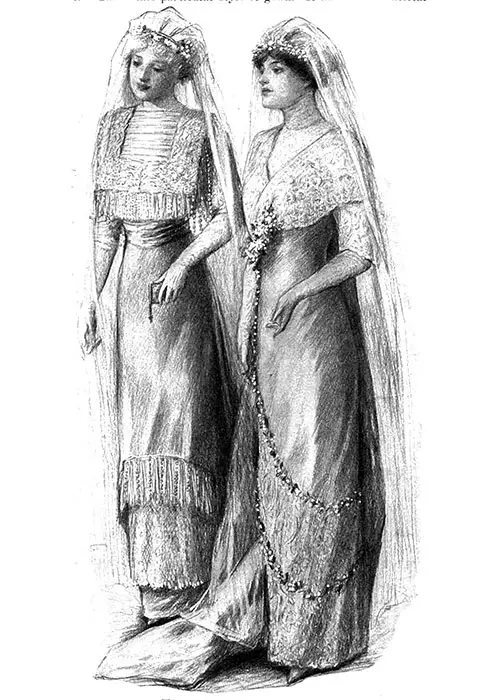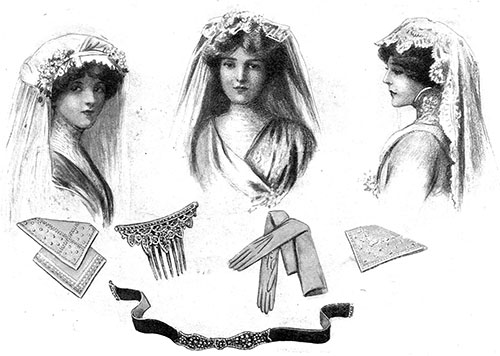Stylish Bridal Gowns for 1912

The new styles this year seem to be, by some kind fortune, especially appropriate for bridal attire. The bertha or fichu drapery of lace, which is so in vogue this year, is a particularly graceful finish for a wedding gown.
Such a gown, when made of satin, is apt to appear too severe and formal about the top of the bodice because of the heavy nature of the material. The rich satins, however, hang beautifully in the skirt and long court train.
Also, these berthas and fichus are just as pretty on the less costly materials, such as messaline, marquisette, and chiffon cloth.
The new skirts, cut with a straight even-length drop skirt, edged with one or two wide flounces of Chantilly lace, have an overskirt of the heavier satin, cut away in front and extending into a long square court train at the back.
Another equally good skirt cut in one with the draped princess bodice is fashioned on simple lines and is cut round length. A square court train is added above the high waist-line behind.
It is attached only at the top, hanging free, and is fully a yard longer than the dress proper. It may be worn for formal occasions only, leaving the gown a practical length for wear at parties.
A beautiful finish to a simple princess gown of this sort is the addition of two or three wide lace flounces set on straight about the lower edge of the drop skirt, or draped from the right hip, obliquely to the left hem, and up again to the waist-line in back as pictured on this page.
Wreaths of orange blossoms make a delightful finish for the top of these lace flounces, a bouquet of the same blossoms finishing the bodice or fichu drapery in front. A draped princess gown fashioned of soft brocaded or plain satin crêpe is among the most beautiful bridal gowns seen this year.
The delightful clinging folds of this fabric make it an ideal one for this particular style of gown. It also has the advantage of making a beautiful ball gown for use after the wedding, if so desired.
The wide material is swathed about the figure draped on a close-fitting bodice lining and a satin drop skirt. The material lies in graceful folds beneath the bust and is draped plainly about the hips.
One corner of the material forms a long pointed train in the back, and the edge crosses the front obliquely, revealing a drop skirt trimmed with flounces of lace on the left side.

The right half of the material and the sleeve are formed of the soft crêpe draped gracefully in surplice style. The left side is formed of white net embroidered in brilliants over shirred white maline.
This maline, shirred horizontally, fills in the V-neck in front. A band of pearl and brilliant trimming outlines the left side of this bodice, and a narrower band finishes the oblique line of the crêpe tunic across the front.
Veils are seldom worn over the face now, even on entering the church. It is much more difficult to arrange a veil becomingly when it is to be thrown back at the altar than when it is worn back all of the time.
Full bridal veils edged with a narrow band of real lace and a row or two of dots are now sold at such reasonable prices in the stores as to tempt even the most economical bride into purchasing one.
There is always the pretty sentiment of the plan to lay it away and keep it for the use of her own daughter and, perhaps, her granddaughter in the faraway future.
Excellent imitations of the real lace veils are sold at a still lower price, and these can scarcely be detected from the real lace even by the experienced eye. Many girls prefer the softer effect of the plain fine tulle.
This is sold in two and three-yard lengths, according to the length of the train. These veils are all arranged beforehand, ready to adjust at the last moment.
"The Bridal Gown" in Harper's Bazar, New York, Harper & Brothers Publishers, Vol. XLVI, No. 3, March 1912, p. 133.
Editor's Note: Some terminology used in the description of women's clothing during the 1800s and early 1900s has been changed to reflect more modern terms. For example, a women's "Toilette" -- a form of costume or outfit has an entirely different common meaning in the 21st century. Typical terms applied to "toilette" include outfit, ensemble, or costume, depending on context.
Note: We have edited this text to correct grammatical errors and improve word choice to clarify the article for today’s readers. Changes made are typically minor, and we often left passive text “as is.” Those who need to quote the article directly should verify any changes by reviewing the original material.

